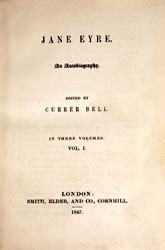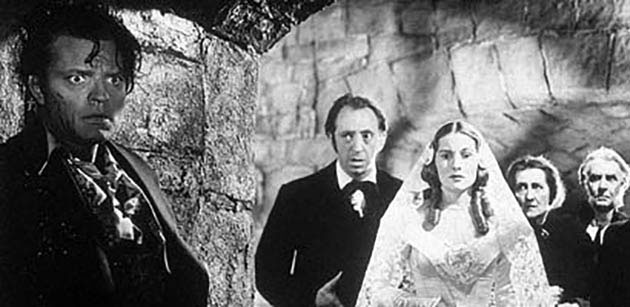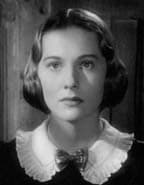Jane Eyre
Critique Quotes Text At the movies
 First edition title page
First edition title pageFirst publication
1847
Literature form
Novel
Genres
Literary, Gothic romance, social criticism
Writing language
English
Author's country
England
Length
Approx. 186,000 words

Eye-opening revelations disrupt nuptials of Rochester (Orson Welles) and Jane (Joan Fontaine).
The dark romantic depths
Jane Eyre (1943): Film, 97 minutes; director Robert Stevenson; writers Aldous Huxley, Robert Stevenson, John Houseman; featuring Joan Fontaine, Orson Welles, Margaret O'Brien, Peggy Ann Garner
Movie adaptations of Jane Eyre have proven to be as popular and enduring as Charlotte Brontė's seminal gothic romance. More than two dozen film and television versions have been produced, starting with two silent takes in 1910 and continuing more than a century later with new Jane Eyres every decade.
What's the attraction? Great storytelling that lends itself well to dramatic presentation, of course. It's not only a dark romance but it's a mystery, a horror story of sorts, a sly critique of organized religion, and a plea for compassion over social niceties—represented through vivid characters in intense situations.
Different visual treatments have emphasized different aspects of the novel, mostly with great success, although none have realized all the attractions of the novel.
In and out the shadows
Made during Hollywood's classic era, Jane Eyre of 1943 is long on the Gothic attractions of the novel.
The black-and-white film seems in fact nearly black and white, with everything either in dark shadow or bright light. Thornfield mansion looks more like a castle in an old horror flick, missing only the lightning at the windows. Mr. Rochester, in the person of Orson Welles pre-corpulent and at his most dashing, often appears as an inhabitant of the shadows as befits his troubled soul, with only his luminous eyes blazing out of the darkness.
But the whitest thing in the movie is Jane Eyre herself, portrayed by a wan Joan Fontaine to represent purity and goodness. Although Fontaine is only in her mid-twenties, she plays much too mature for the Jane of the novel who is supposed to be barely out of her teens, if even that. She is so lacklustre it's hard to understand why an experienced rogue like Rochester would fall for her.
I much prefer the younger, spunkier Jane in this film, essayed by child actor Peggy Ann Garner (who later went on to fame as fanciful tyke Francie in A Tree Grows in Brooklyn). She plays alongside an uncredited early Elizabeth Taylor as inmates of the oppressive Lowood School for Girls.
Besides its shadowy look, the film is also noteworthy for outdoor vistas that are realistic for its time. Despite the film having been shot entirely in a studio, pervasive mist and clever perspective shots create the appearance of moors that stretch on for miles around the isolated mansion. Welles is said to have been behind these effects that recreate the novel's foreboding atmosphere.
Welles's fingerprints are in fact all over this film and it's been suggested he acted as an unofficial co-producer on Jane Eyre. The film is actually based on a radio adaptation of the novel by his theatre company.
Welles is also the real star of this Jane Eyre, coming close to personifying the master of the house that everyone pictures when they read Brontė. The story is reduced in this hour-and-a-half movie to leave the focus on Rochester's interactions with Jane. Episodes in the young woman's early life and education are drastically curtailed and her later refuge with the Rivers siblings, which takes up a quarter of the book, is cut out altogether. Her latter flight from Thornfield is reduced to a visit to her dying aunt.
But this abridgment works wonderfully, which may be attributed to the earlier radio adaptation or perhaps to the inclusion on the scripting team of the great novelist Aldous Huxley and the esteemed actor/producer John Houseman, who had a long association with Welles. The romantic high points of the novel are spliced together smoothly to provide a seamlessly emotional experience, in that old-style Hollywood melodramatic fashion.
Trailer for 1943's intense adaptation of Jane Eyre appeals to book readers.
We never cast eyes directly on the face of the mysterious woman in the attic. But thanks to clever bits of stage business we think we do, as we see her through the reactions of others.
Another intermittent illusion is created through narration of what appears to be introductory and bridging sections of the novel's text shown onscreen. Anyone with the book however can confirm these linking passages are entirely made up. Like much of this film, they create the appearance of being faithful to the novel while changing it extensively.
Despite all the fine aspects of this film, fans of the novel will probably be disappointed, as without all the nuance the plot comes together too easily, perhaps exposing the artifice of the original work in broad outline. One part of the original work kept is the corny tacked-on ending in which we're told everything works out well for our protagonists in their future life together.
Later adaptations will take more realistic and complete approaches to Jane Eyre. But they will lose much of this one's dash and darkness.
— Eric


